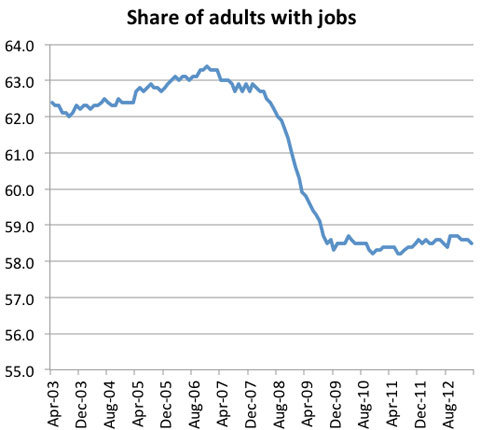Spare a moment for an overlooked economic indicator: The employment rate.
The government said Friday that 58.5 percent of Americans over the age of 16 had jobs in March.
This employment rate has held remarkably steady since 2010, never higher than 58.7 percent or lower than 58.2 percent. Job creation has basically kept pace with population growth. Nothing more. The share of Americans with jobs is still stuck about 5 percentage points lower than before the recession.
 Source: Bureau of Labor Statistics
Source: Bureau of Labor Statistics
This may seem surprising. After all, the unemployment rate — the labor market indicator that gets all the attention — has fallen from 9.8 percent to 7.6 percent over the same three-year period.
It’s only surprising, however, because people tend to treat the unemployment rate as an inverse of the employment rate. But notice that the two numbers do not sum to 100 percent. About 34 percent of Americans are missing: People who don’t have jobs, and are not actively looking.
Some of those people are retired or disabled. Some are stay-at-home parents. And some of them have stopped looking for work because they have given up hope of finding work. The government estimates membership in each of these groups. It is clear, for example, that a growing share of Americans is elderly. But it is impossible to know how many 66-year-olds would return to work if jobs were available, or how many parents would put children in day care if they could earn enough to cover the cost.
The unemployment rate treats all of these people as invisible. The employment rate treats them all as potential workers. The truth surely lies in between: It has become a little easier, but not much, to find work if you want it.
Article source: http://economix.blogs.nytimes.com/2013/04/05/the-employment-rate/?partner=rss&emc=rss